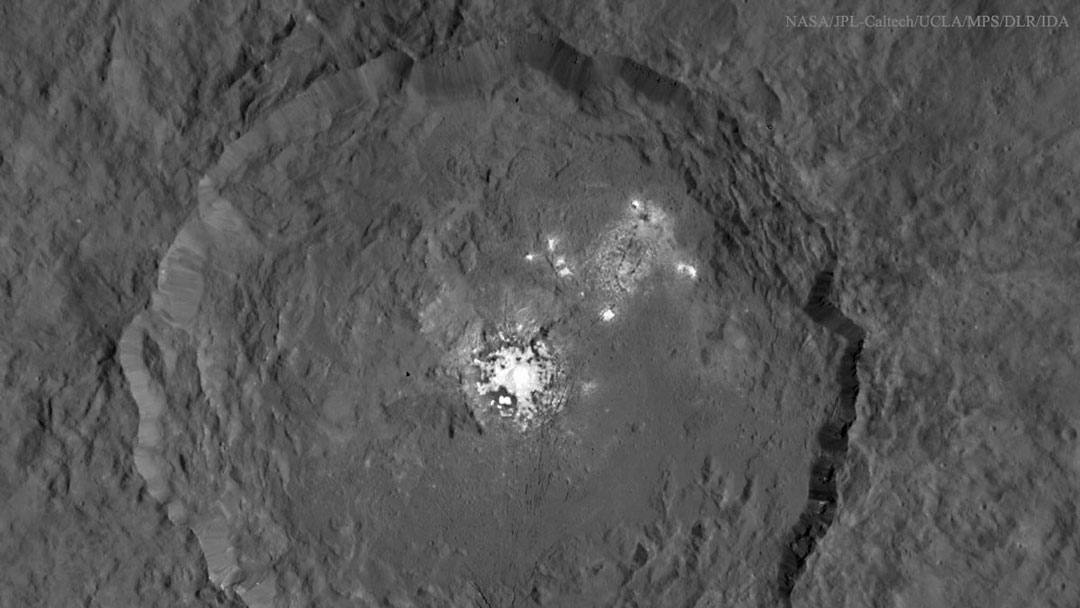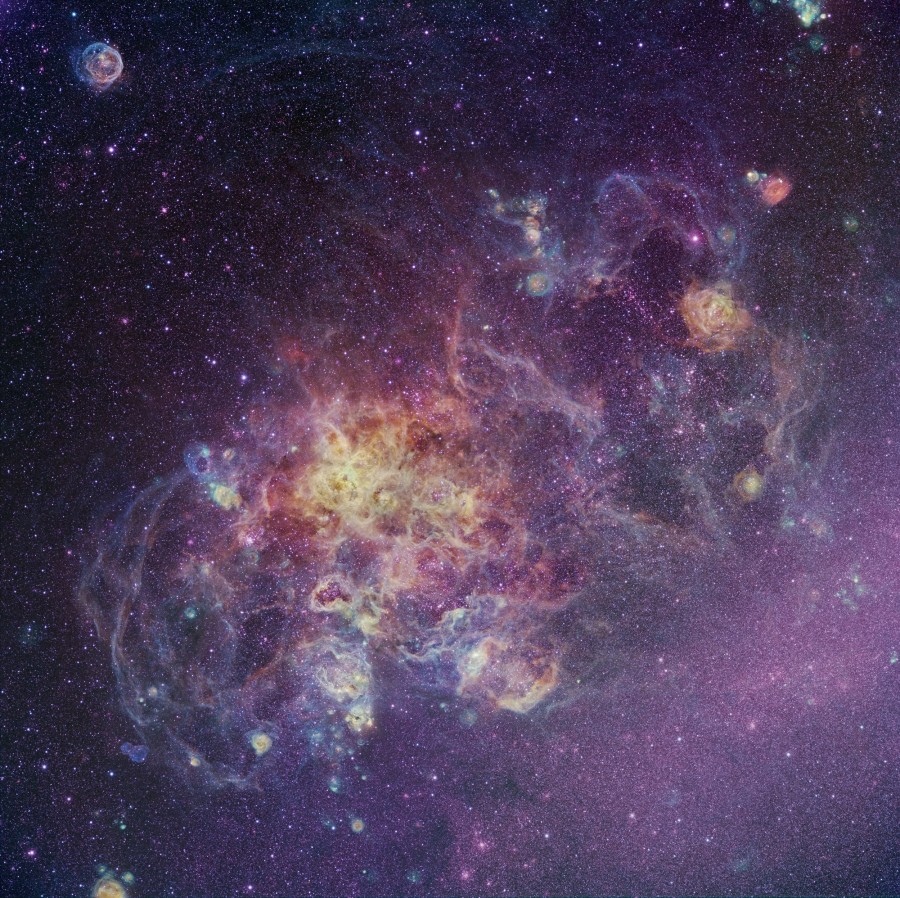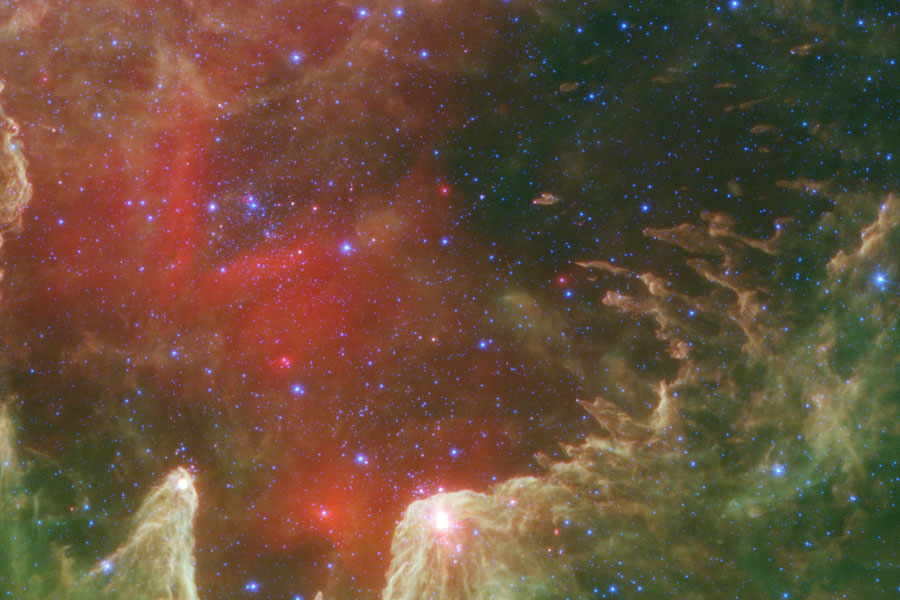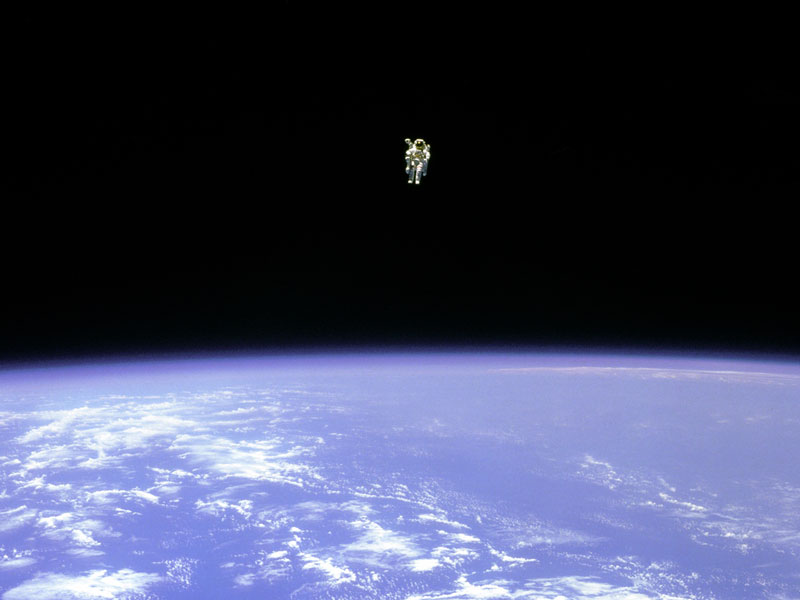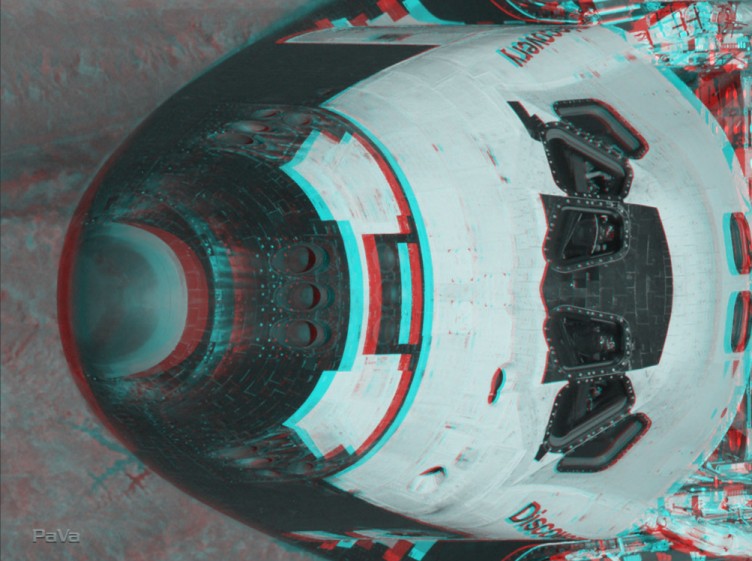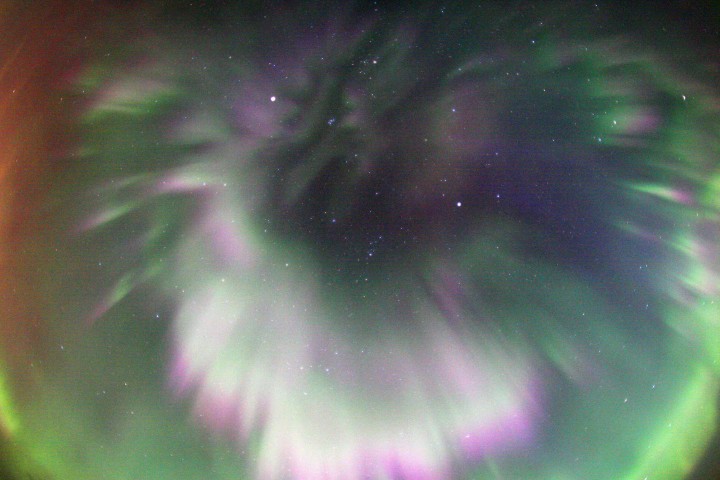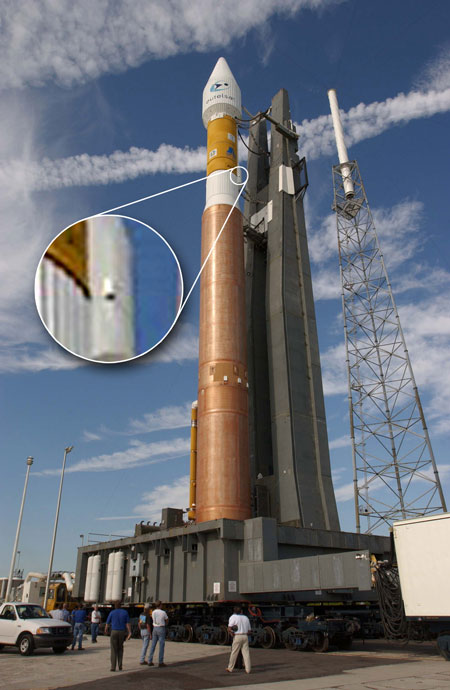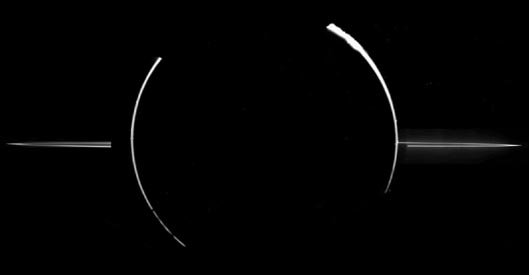APOD Retrospective: September 16
Posted: Fri Sep 16, 2011 4:00 am
| << Previous | Index | Next >> |
2015 What created these bright spots on Ceres? The spots were first noted as the robotic Dawn spacecraft approached Ceres, the largest object in the asteroid belt, in February, with the expectation that the mystery would soon be solved in higher resolution images. However, even after Dawn arrived at Ceres in March, the riddle remained. Surprisingly, although images including the featured composite taken in the last month do resolve many details inside Occator crater, they do not resolve the mystery. Another recent clue is that a faint haze develops over the crater's bright spots. Dawn is scheduled to continue to spiral down toward Ceres and scan the dwarf planet in several new ways that, it is hoped, will determine the chemical composition of the region and finally reveal the nature and history of the spots. In several years, after running out of power, Dawn will continue to orbit Ceres indefinitely, becoming an artificial satellite and an enduring monument to human exploration.
2014
[imghover6=http://apod.nasa.gov/apod/image/1409/At ... ca_960.jpg]http://apod.nasa.gov/apod/image/1409/At ... otated.jpg[/imghover6]Image Credit & Copyright: Alex Tudorica (AIfA, U. Bonn)
2013
Click to play embedded YouTube video.
Credit: LRO, Arizona State U., NASA
2012 How old are Saturn's rings? No one is quite sure. One possibility is that the rings formed relatively recently in our Solar System's history, perhaps only about 100 million years ago when a moon-sized object broke up near Saturn. Evidence for a young ring age includes a basic stability analysis for rings, and the fact that the rings are so bright and relatively unaffected by numerous small dark meteor impacts. More recent evidence, however, raises the possibility that some of Saturn's rings may be billions of years old and so almost as old as Saturn itself. Inspection of images by the Saturn-orbiting Cassini spacecraft indicates that some of Saturn's ring particles temporarily bunch and collide, effectively recycling ring particles by bringing fresh bright ices to the surface. Seen here, Saturn's rings were imaged in their true colors by the robotic Cassini in late October. Icy bright Tethys, a moon of Saturn likely brightened by a sandblasting rain of ice from sister moon Enceladus, is visible in front of the darker rings.
2011 A Full Moon rising can be a dramatic celestial sight, and Full Moons can have many names. For example, Monday's Full Moon was the one nearest this year's autumnal equinox for the northern hemisphere, traditionally called the Harvest Moon. According to lore the name is a fitting one because farmers could work late into the night at the end of the growing season harvesting crops by moonlight. This serene telephoto image captures this September's harvest moonrise from Turin, Italy. In silhouette against an orange lunar disk is Turin's hilltop Basilica of Superga.
2010 Delicate in appearance, these filaments of shocked, glowing gas, draped in planet Earth's sky toward the constellation of Cygnus, make up the Veil Nebula. The nebula is a large supernova remnant, an expanding cloud born of the death explosion of a massive star. Light from the original supernova explosion likely reached Earth over 5,000 years ago. Also known as the Cygnus Loop, the Veil Nebula now spans nearly 3 degrees or about 6 times the diameter of the full Moon. That translates to over 70 light-years at its estimated distance of 1,500 light-years. In fact, the Veil is so large its brighter parts are recognized as separate nebulae, including The Witch's Broom (NGC 6960) at the bottom of this stunning skyview and Pickering's Triangle (NGC 6979) below and right of center. At the top is the haunting IC 1340.
2009 The Tarantula Nebula is more than 1,000 light-years in diameter -- a giant star forming region within our neighboring galaxy the Large Magellanic Cloud (LMC). That cosmic arachnid lies left of center in this sharp, colorful telescopic image taken through narrow-band filters. It covers a part of the LMC over 2,000 light-years across. Within the Tarantula (NGC 2070), intense radiation, stellar winds and supernova shocks from the central young cluster of massive stars, cataloged as R136, energize the nebular glow and shape the spidery filaments. Around the Tarantula are other violent star-forming regions with young star clusters, filaments and bubble-shaped clouds. The rich field is about as wide as the full Moon on the sky, located in the southern constellation Dorado.
2008 How do stars form? A study of star forming region W5 by the sun-orbiting Spitzer Space Telescope provides clear clues by recording that massive stars near the center of empty cavities are older than stars near the edges. A likely reason for this is that the older stars in the center are actually triggering the formation of the younger edge stars. The triggered star formation occurs when hot outflowing gas compresses cooler gas into knots dense enough to gravitationally contract into stars. Spectacular pillars, left slowly evaporating from the hot outflowing gas, provide further visual clues. In the above scientifically-colored infrared image, red indicates heated dust, while white and green indicate particularly dense gas clouds. W5 is also known as IC 1848, and together with IC 1805 form a complex region of star formation popularly dubbed the Heart and Soul Nebulas. The above image highlights a part of W5 spanning about 2,000 light years that is rich in star forming pillars. W5 lies about 6,500 light years away toward the constellation of Cassiopeia.
2007 At about 100 meters from the cargo bay of the space shuttle Challenger, Bruce McCandless II was further out than anyone had ever been before. Guided by a Manned Maneuvering Unit (MMU), astronaut McCandless, pictured above, was floating free in space. McCandless and fellow NASA astronaut Robert Stewart were the first to experience such an "untethered space walk" during Space Shuttle mission 41-B in 1984. The MMU works by shooting jets of nitrogen and has since been used to help deploy and retrieve satellites. With a mass over 140 kilograms, an MMU is heavy on Earth, but, like everything, is weightless when drifting in orbit. The MMU was replaced with the SAFER backpack propulsion unit.
2006 Approaching the International Space Station on STS-121 in July, the Shuttle Orbiter Discovery posed for a series of photographs. The process was part of an inspection to check for damage to the orbiter, but against the backdrop of planet Earth 300 kilometers below, the pictures themselves are stunning. Stereo artist Patrick Vantuyne has combined two of them (ISS013e48787 and ISS013e48788) to produce this dramatic 3D image. The stereo anaglyph is intended to be viewed with red/blue glasses. Details visible along the forward fuselage include high temperature (black) and low temperature (white) insulation tiles, thrusters used for steering and attitude control, and crew compartment windows.
2005 So far, the Aurora Borealis or Northern Lights have made some remarkable visits to September's skies. The reason, of course, is the not-so-quiet Sun. In particular, a large solar active region now crossing the Sun's disk has produced multiple, intense flares and a large coronal mass ejection (CME) that triggered wide spread auroral activity just last weekend. This colorful example of spectacular curtains of aurora was captured with a fish-eye lens in skies over Quebec, Canada on September 11. Also featured is the planet Mars, the brightest object above and left of center. Seen near Mars (just below and to the right) is the tightly knit Pleiades star cluster. Although they can appear to be quite close, the northern lights actually originate at extreme altitudes, 100 kilometers or so above the Earth's surface.
2004 Microquasars, bizarre binary star systems generating high-energy radiation and blasting out jets of particles at nearly the speed of light, live in our Milky Way galaxy. The energetic microquasar systems seem to consist of a very compact object, either a neutron star or a black hole, formed in a supernova explosion but still co-orbiting with an otherwise normal star. Using a very long array of radio telescopes, astronomers are reporting that at least one microquasar, LSI +61 303, can be traced back to its probable birthplace -- within a cluster of young stars in the constellation Cassiopeia. About 7,500 light-years from Earth, the star cluster and surrounding nebulosity, IC 1805, are shown in the deep sky image above. The cluster stars are identified by yellow boxes and circles. A yellow arrow indicates the common apparent motion of the cluster stars, the green arrow shows the deduced sky motion of the microquasar system, and the red arrow depicts the microquasar's motion relative to the star cluster itself. Seen nearly 130 light-years from the cluster it once called home, a powerful kick from the original supernova explosion likely set this microquasar in motion.
2003 Where will Hurricane Isabel go? One of the stronger storm systems of modern times appears headed for one the more populated seaboards on planet Earth -- the east coast of the USA. Hurricane Isabel, pictured yesteday as it passed east of the Bahamas, has flirted with category 5 status, the most powerful hurricane category. Hurricanes are huge swirling storms with cloud systems typically larger than a state. Tropical cyclones, called hurricanes in Earth's Western Hemisphere and typhoons in the Eastern Hemisphere, get their immense energy from warm evaporated ocean water. As this water vapor cools and condenses, it heats the air, lowers pressure and hence causes cooler air to come swooshing in. Winds can reach over 250 kilometers per hour and become very dangerous. Much remains unknown about cyclones, including how they are formed and the exact path they will take.
2002 The first launch of an Atlas V rocket occurred last month. The Atlas V, built by Lockheed Martin, is the first rocket in the U. S. Air Force's Evolved Expendable Launch Vehicle program. Rockets in this program can carry increasingly heavy payloads by just adding more boosters. In fact, the only US expendable rocket capable of lifting more was the Saturn V that carried people to the Moon. Atlas rockets have a reputation for being extremely reliable -- the current launch was the 61st consecutive successful launch for an Atlas. Highlighted in the inset is the small RocketCam camera that sent back pictures from the rocket during launch.
2001 If you could look at Venus with radar eyes - this is what you might see. This computer reconstruction of the surface of Venus was created from data from the Magellan spacecraft. Magellan orbited Venus and used radar to map our neighboring planet's surface between 1990 and 1994. Magellan found many interesting surface features, including the large circular domes, typically 25-kilometers across, that are depicted above. Volcanism is thought to have created the domes, although the precise mechanism remains unknown. Venus' surface is so hot and hostile that no surface probe has lasted more than a few minutes.
2000 Above is a picture of the Earth in x-rays, taken in March of 1996 from the orbiting Polar satellite. Most of the planet is dark with superposed continent and coordinate grids, while the bright x-ray emission near the north pole is shown in red. Why does the Earth have an x-ray glow? Actually, the Earth itself does not, but the aurora high in the Earth's atmosphere do glow with x-rays detectable by space-based instruments. Gusts of energetic ions from the Sun can distort the Earth's magnetosphere allowing high energy electrons spiraling along magnetic field lines to slam into the upper atmosphere above the magnetic poles. This activity causes shimmering visible aurora along with x-ray, ultraviolet, and radio emission. The x-rays are not dangerous to life on Earth because they are absorbed by the dense, lower atmosphere.
1999 Watch closely. As this animation blinks between two Hubble Space Telescope images of NGC 6543 - the first from 1994 and the second from 1997 - the intricate filaments of this nebula are seen to shift. The shift is due to the actual expansion of this gaseous shroud shed by a dying star! NGC 6543 is more popularly known as the Cat's Eye Nebula. Classified as a "planetary nebula", its complex, interwoven shells of expanding gas have been castoff by the central star as it evolves from a red giant to its final white dwarf phase. The planetary nebula phase of a star's life is known to be relatively brief, lasting 10,000 years or so. In fact, combined with other data, this nebula's detectable shift over a three year period allows the expansion age of its bright inner shells to be estimated at only around 1,000 years while its distance can be gauged at about 3,000 light-years.
1998 Why does Jupiter have rings? Jupiter's rings were discovered in 1979 by the passing Voyager 1 spacecraft, but their origin has always been a mystery. Recent data from the Galileo spacecraft currently orbiting Jupiter now confirms that these rings were created by meteoroid impacts on small nearby moons. As a small meteoroid strikes tiny Adrastea, for example, it will bore into the moon, vaporize, and explode dirt and dust off into a Jovian orbit. Pictured above is an eclipse of the Sun by Jupiter, as viewed from Galileo. Small dust particles high in Jupiter's atmosphere, as well as the dust particles that compose the rings, can be seen by reflected sunlight.
1997 Fighting clouds and the glow of city lights, a young Moon shines over the western horizon of Mongolia's capital Ulaan-Baatar. The thin sunlit crescent is 1.5 days old and strongly over exposed in this image taken on March 10. The night side of the moon is also visible due to Earthshine - sunlight reflected from the Earth to the Moon. Just below the Moon, bright Saturn shines through the clouds. Early morning risers can see the Moon near Saturn this week. In fact, from North America the Moon can be seen to pass in front of the ringed planet on Thursday morning, September 18th.
1996 The Sun is a seething ball of extremely hot gas. Above, the Sun was captured by Skylab in 1973 throwing off one the largest eruptive prominences in recorded history. The Sun has survived for about 5 billion years, and will likely survive for another 5 billion. The Sun is not on fire, will never explode, and a solar flare will never destroy the Earth. The Sun continues to present many unanswered questions. For example: Why is the Sun's corona so hot? What causes the Sun's unusual magnetic field? Why does the Sun's center emit so few neutrinos?
1995 Robert H. Goddard, one of the founding fathers of modern rocketry, was born in Worcester Massachusetts in 1882. As a 16 year old, Goddard read H.G. Wells' science fiction classic "War Of The Worlds" and dreamed of spaceflight. By 1926 he had designed, built, and launched the world's first liquid fuel rocket. During his career he was ridiculed by the press for suggesting that rockets could be flown to the Moon, but he kept up his experiments in rocketry supported in part by the Smithsonian Institution and championed by Charles Lindbergh. Pictured above in 1937 in the desert near Roswell New Mexico, Goddard examines a nose cone and parachute from one of his test rockets. Widely recognized as a gifted experimenter and engineering genius, his rockets were many years ahead of their time. He died in 1945 holding over 200 patents in rocket technology. A liquid fuel rocket constructed on principles developed by Goddard landed humans on the Moon in 1969.
| << Previous | Index | Next >> |
